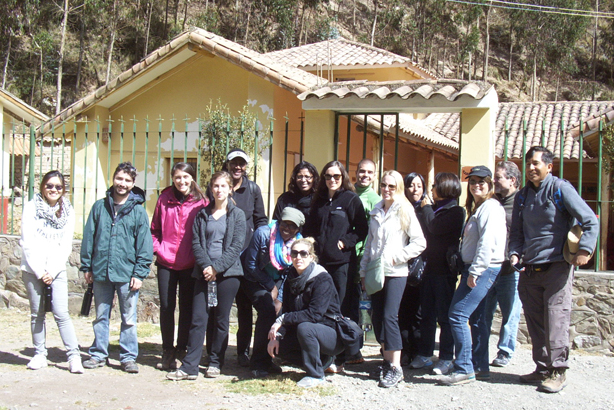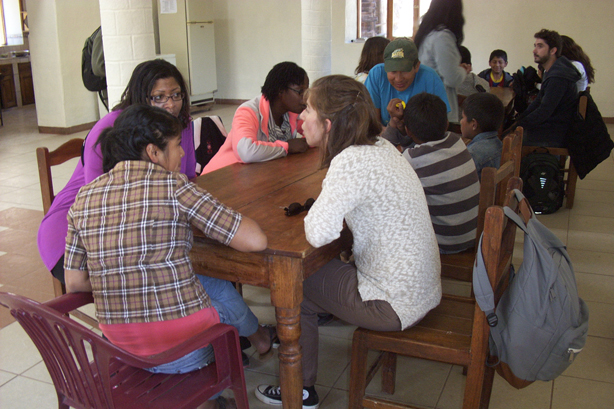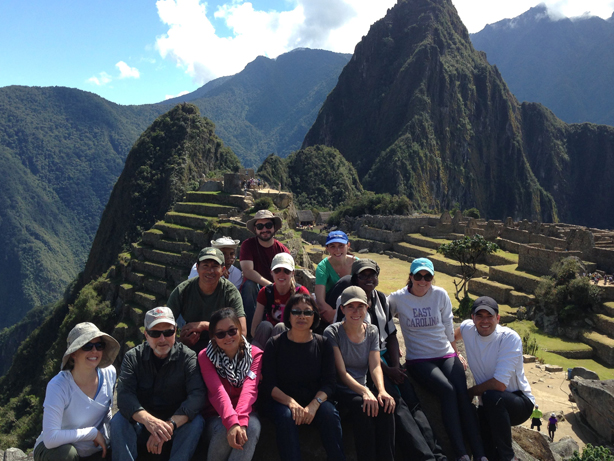
In June of 2014, Counselors Without Borders and the Graduate Counseling Program from George Mason University sponsored an 11-day cross-cultural summer program in Peru. Our group was made of 12 graduate counseling students, led by Dr. Fred Bemak, Dr. Rita Chi-Ying Chung, and doctoral student Ricardo Sanchez. Peru is known for being one of the nicest tourist destinations in Latin America, but ours was less of a tour and more of a cultural-counseling experience with a social justice eye.
The summer program was designed to offer graduate students the opportunity to interact and provide service learning to people from marginalized indigenous communities as part of their cross-cultural and social justices training—two of the prominent areas of concentration in the counseling program at GMU. By ‘cross-cultural,’ we meant being with the adults and children in the orphanages, shelters, and schools in several communities in the Cuzco area while learning about the social context in which mental health is experienced among the adults and children. The cross-cultural experience also included learning from a Native elder and Quechua professor, Evaristo Pfuturi, who complimented our experience by providing us with the Inca perspective on life and well-being.
Most of the children we visited at the shelters and orphanages came from broken families or were abandoned due to domestic violence, parental alcoholism, and extreme poverty. Marginalization and violence among Indigenous populations can be traced to the long-standing colonial culture of oppression in the Andes. Centuries of European colonization and oppression have contributed to the social and political unrest that still affects people today.
The systemic marginalization of Indigenous communities resulted in poverty and lack of education and basic health services. Some benefits of prosperity and democracy were sporadically and reluctantly passed onto the masses via a painful, trickle-down effect that still continues today.
The Hacendado system, for example, which permitted landlord-owners of large plantations to essentially own hundreds of Indians under slave-like conditions, was legally protected under Peruvian law until the Agrarian Reform of 1968. Indigenous peoples who disobeyed their landlords were frequently physically punished and publically humiliated, with no protection under the law. Many indigenous elders across the Andes still remember the physical and psychological wounds of that era. The effects of this cycle of transmission of landlord-to-Indian intergenerational trauma are still vividly apparent among indigenous families across the Andes. It is common for men in the Andes to act like the landlord at home and to show their manhood by physically punishing their wives and children. Also common is a tendency among Andean men to suppress their anger and depression and to “self-medicate” with alcoholism. Ridiculing a man for not keeping his woman “in check” is one of the highest offenses a man can suffer, just as landlord-owners used to be called out if their peers perceived them as not capable of keeping their Indians in-check. Qero’ Indians still recall being forced to keep watch over fruit crops like human scarecrows, protecting the fruit from mosquitos and bugs 24 hours per day, 7 days per week. A less than perfect fruit not only meant physical punishment for the scarecrow Indian; it was also a sign that the landlord-owner was incapable of keeping his Indians in-check and demonstrating his power over them. Transgenerational violence and trauma across the Andes is a topic that requires a great deal of study, as it is at the root of the region’s serious domestic violence problem.
Children in the Casas Hogares—Home shelters—are in great need of systemic assistance. Many NGOs provide assistance, especially in remote areas where government presence is still non-existent. In spite of a lack of funding and support from government agencies, these NGOs do what they can. Assisting the psychological needs of orphaned and abandoned children is a challenge when funding is limited to covering only basic food and shelter. In such settings, linguistic and cultural needs are for the most part left unattended. At an elementary school in a community near the town of Ollantaytambo, we met a Quechua-speaking girl who had never spoken about her fears and the fact that she had been bullied for years. Her parents were separated due to violence at home; she lived in an impoverished home with her mom and two siblings, always longing the return of her father. In addition, she couldn’t speak or understand Spanish, which in Peru is often a source for mocking. The school had neither trained bilingual mental health professionals nor anyone with multicultural sensitivity to attend children in situations like this. Although bilingual education in Quechua speaking communities had recently begun to attract the attention of Peruvian education authorities, most Quechua-speaking children who live in rural areas do not receive an appropriate culturally sensitive education.
For example, Indigenous cultural traditions in Peru value respect for natural life, and reciprocity among all members of the community. It also values the promotion of equitable treatment to achieve well-being for all. Instead, schools in indigenous communities provide books and follow a Western-curricula that are incompatible with the indigenous cultural context, negatively impacting their development and self-teem perpetuating the cycle of poverty and dependence.
But new initiatives are beginning to emerge from within indigenous communities that provide hope in Peru. We visited Wiñaypaq, a culturally centered elementary school in Cuzco’s Sacred Valley. While the Peruvian Ministry of Education accredits it, it does not provide funding perhaps to due to the lack exciting channels to accommodate culturally centered schools. In stark contrast with most schools, this school is aligned with its students’ ancestral teachings. When we arrived, the children received us not with words or physical gifts; instead, they asked us to join them in a communal dance, and we all held hands and danced together in a big circle. Another group of children in the middle of the circle sang welcoming songs in Quechua and in Spanish and played zampoñas—Andean pan flutes—and bombos—drums made of Alpaca and Llama hides, which were strapped to their necks. Cultural respect, gratitude, and a welcoming spirit couldn’t have been taught better than it was in this 20-minute joyful event. As part of the curriculum, children have daily assignments that cultivate their connection with nature and communal life. They water the garden and plant local vegetables in the small farming area adjacent to the school. They learn about the benefits of keeping a clean environment and they apply what they learn in their daily activities. In the classrooms, they learn the normal curricula (math, natural sciences, etc.), but they also use a team approach to solve problems. For example, they are encouraged to brainstorm and come up ideas to improve their school. With assistance from their teachers, students turn ideas into written proposals which ultimately may be converted into a letter to the town mayor, community leaders or donors to request support for the construction of a new classroom or a new solar-powered cookstove for the school, for example. During arts and crafts class, children may collectively create their own colorful school backpacks. As one of the teachers explained, making and wearing their own backpacks or hats not only develops their sense of belonging and self-esteem, it also minimizes perceived differences among them and lessens the illusion of separateness. In a community where people see each other as equals, allowing a few students to have Spiderman or Sponge Bob backpacks while others have only a plastic bag sends an awkward message to students and creates unnecessary conflicts among them.
While bilingual schools are slowly being implemented in areas where Spanish is not the main language, schools like Wiñaypaq are still rare in Peru. They constitute an innovative approach that follows a truly culturally-centered education. Although it may seem that the school is going against all odds, given the rigidly standardized Peruvian educational system, this school offers a model that Peruvian education authorities could adopt in other communities in the Andes to promote a culture of inclusiveness.
While in Peru, we were cognizant that we were not there to teach our ways or impose our beliefs upon the population. Rather, we were there to be there and to be of service to them, whether by drawing and painting with the children, playing basketball or soccer, or letting the girls braid the hair of some of our graduate students. As some of our graduates students said later about our summer program in Peru, “our lives have been transformed by being exposed to the teachings of the Incan elders and their sacred places, while seeing and appreciating the world from the eyes of a Peruvian indigenous orphan or a Quechua elder sharing his happy and sad stories.”


